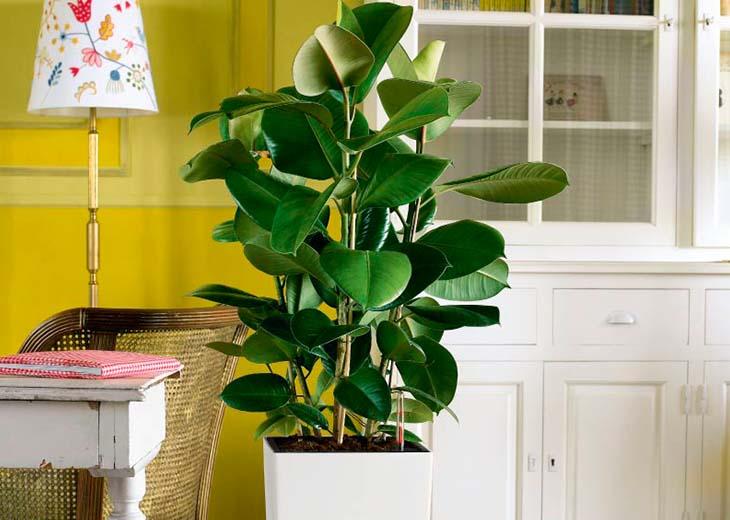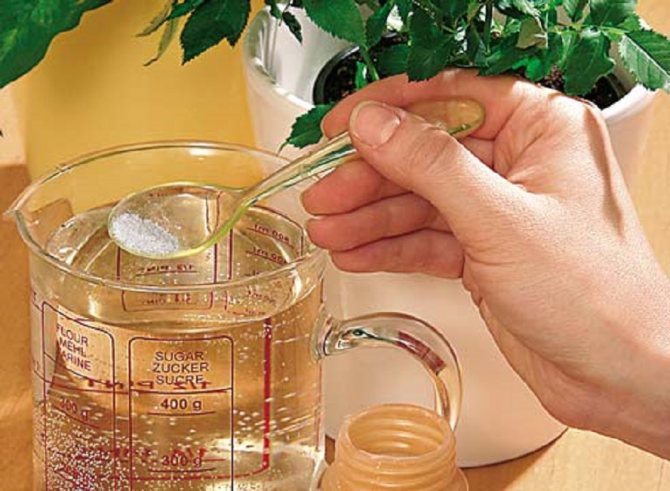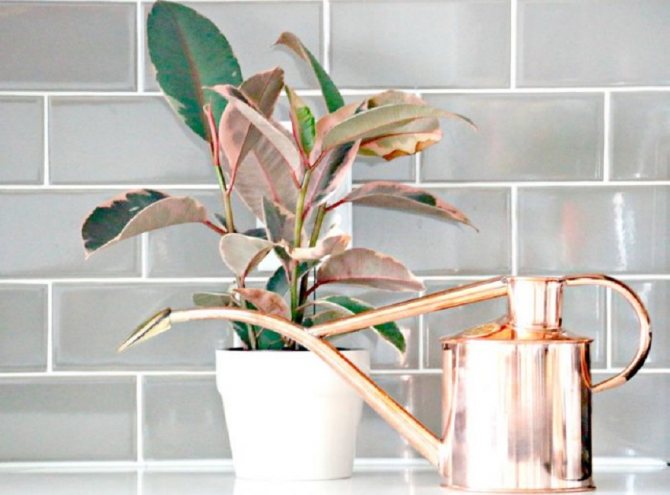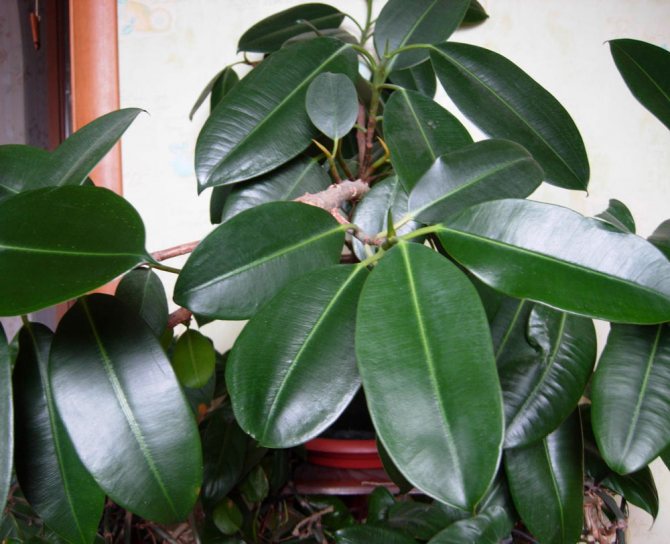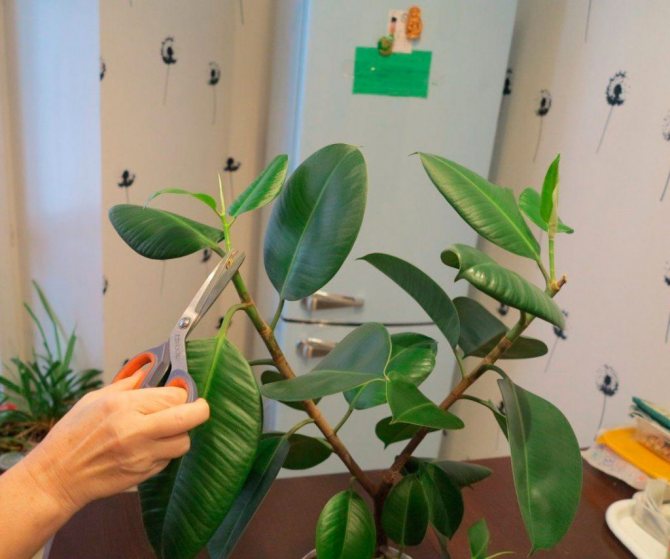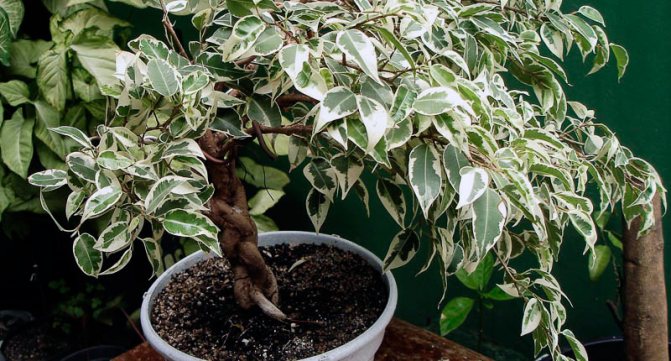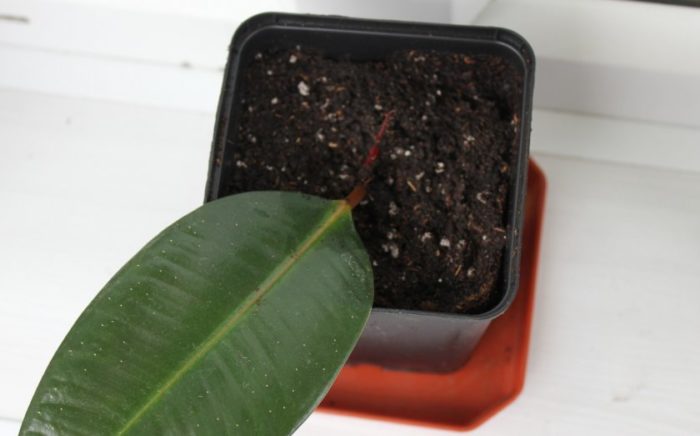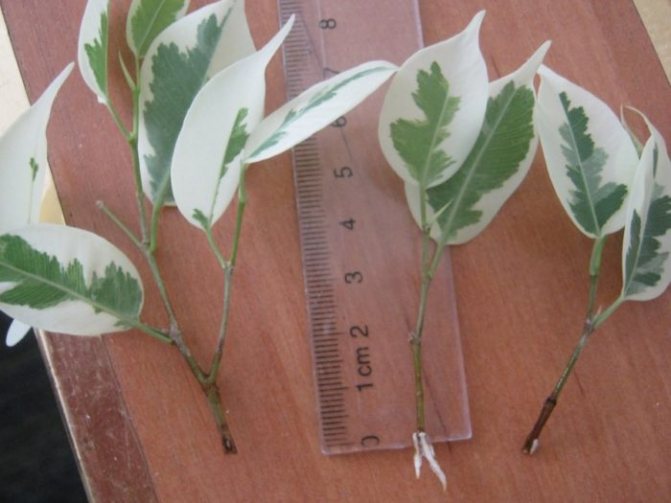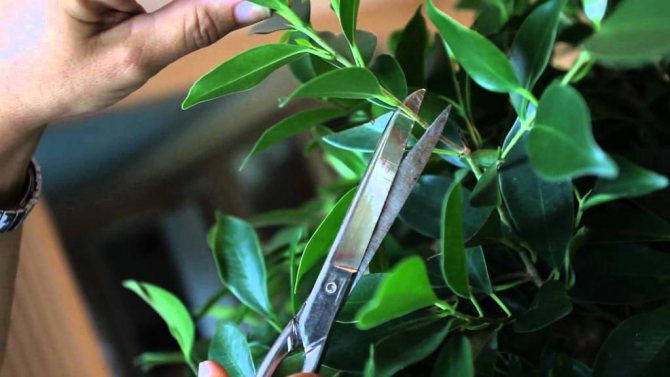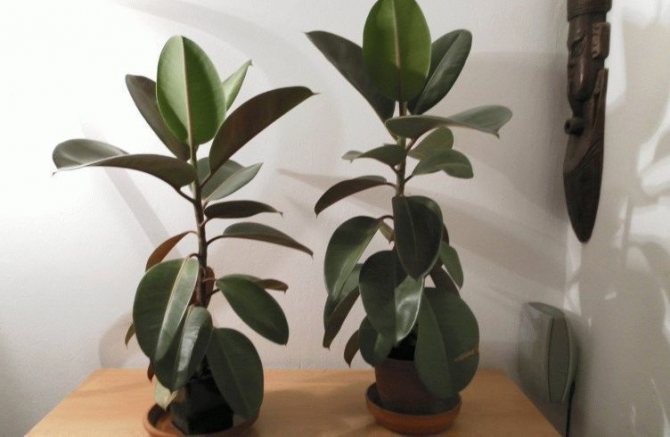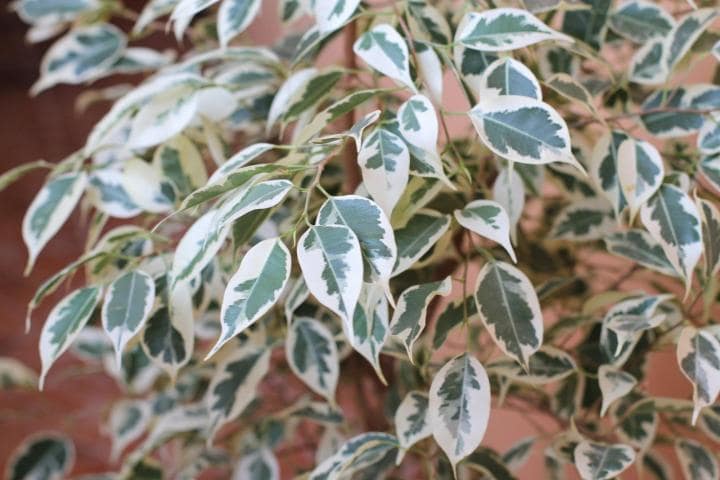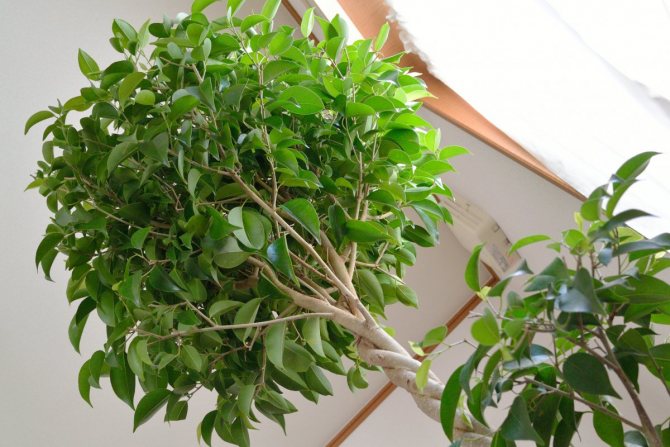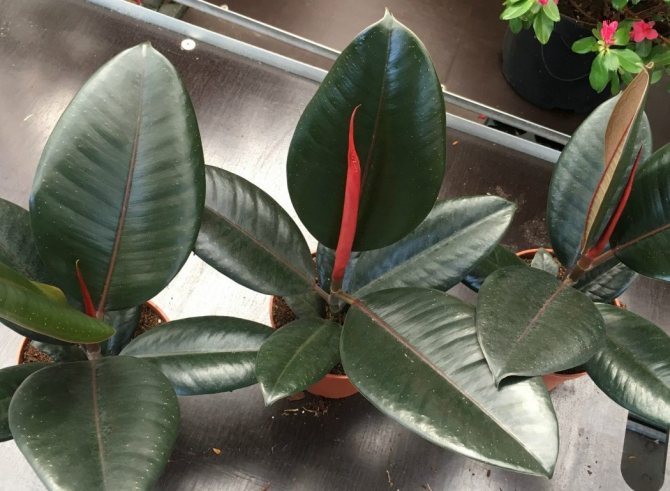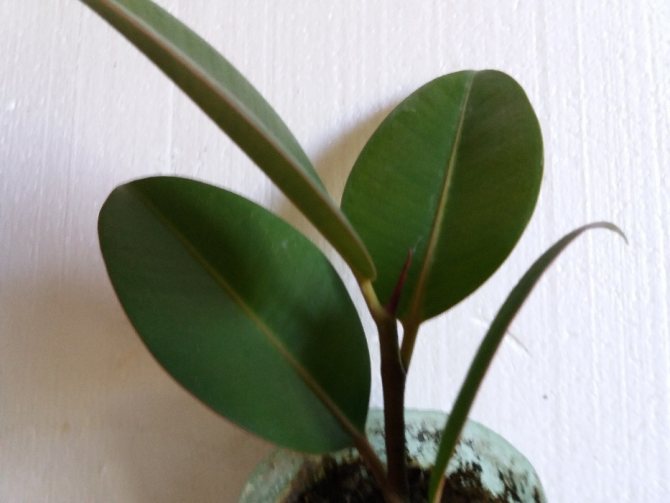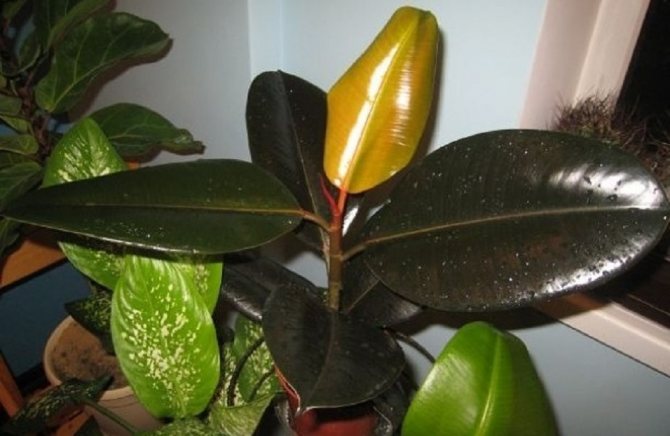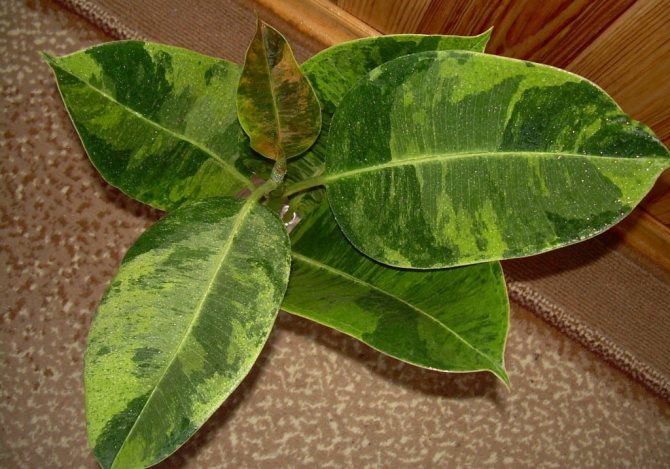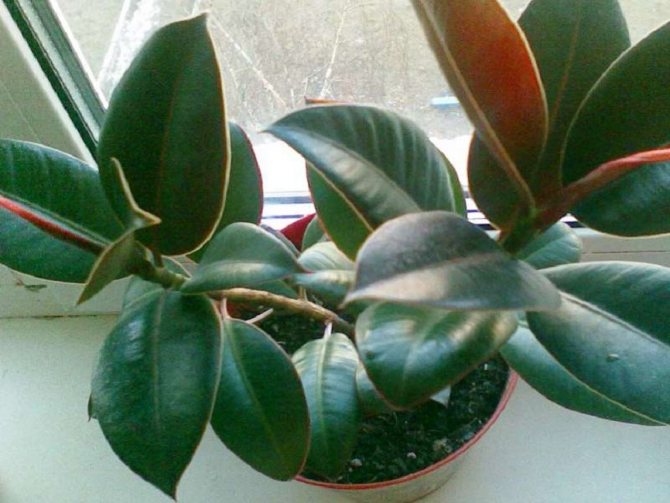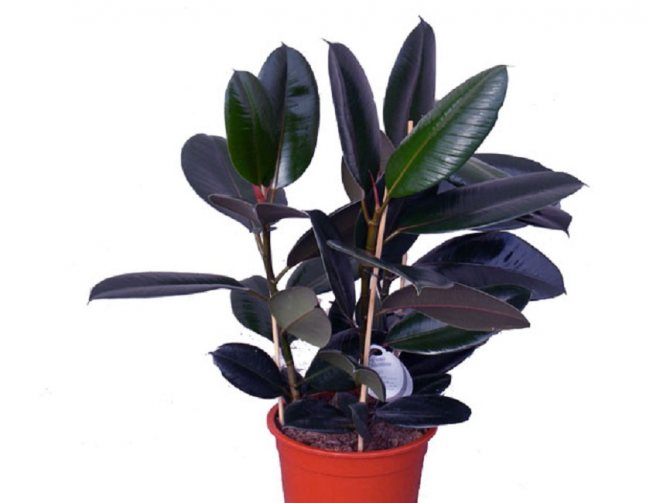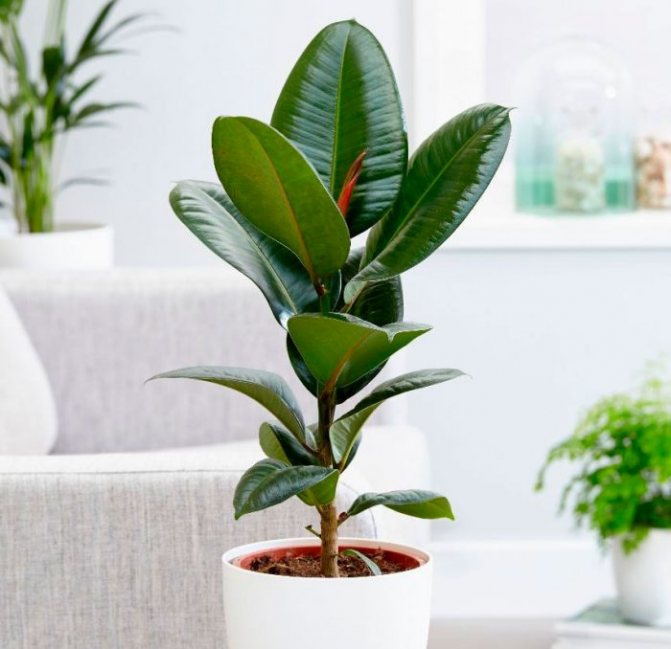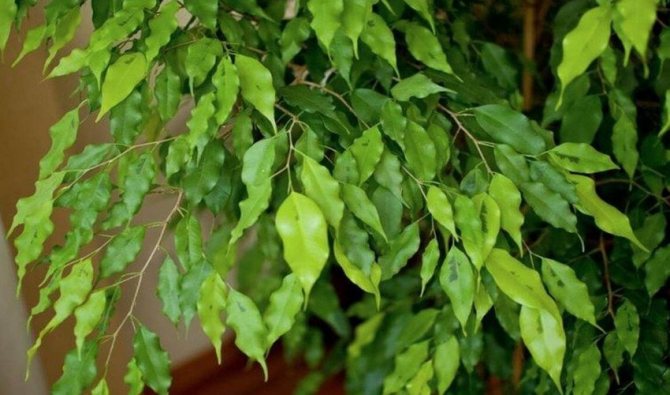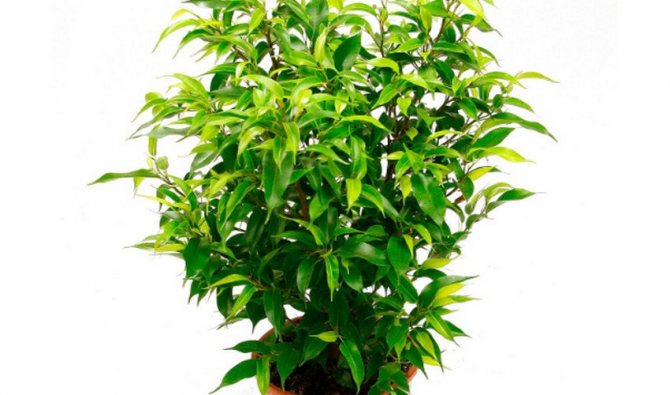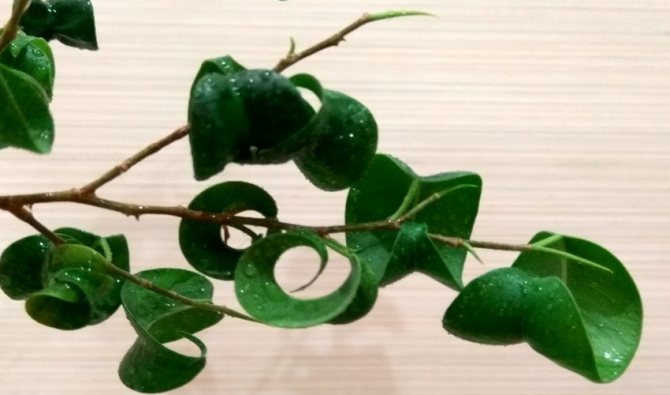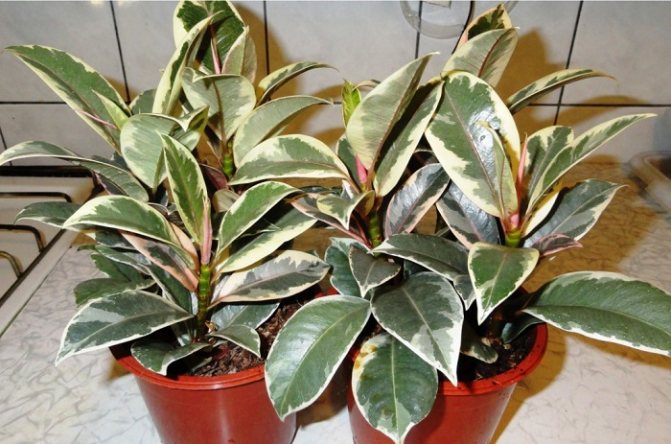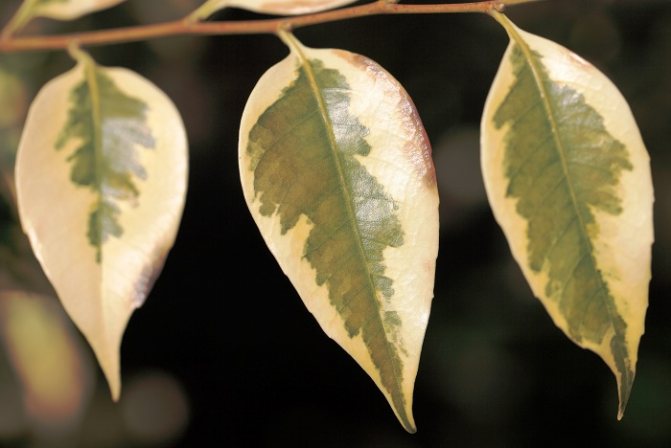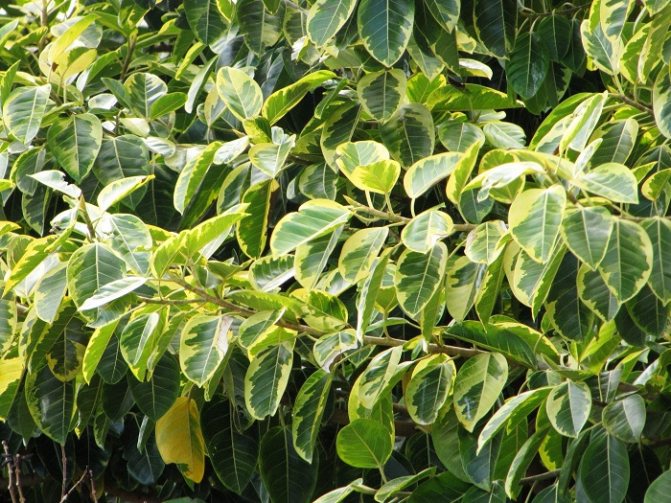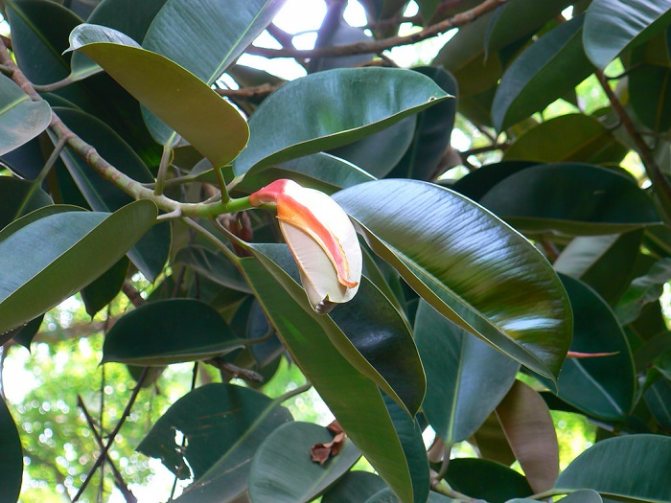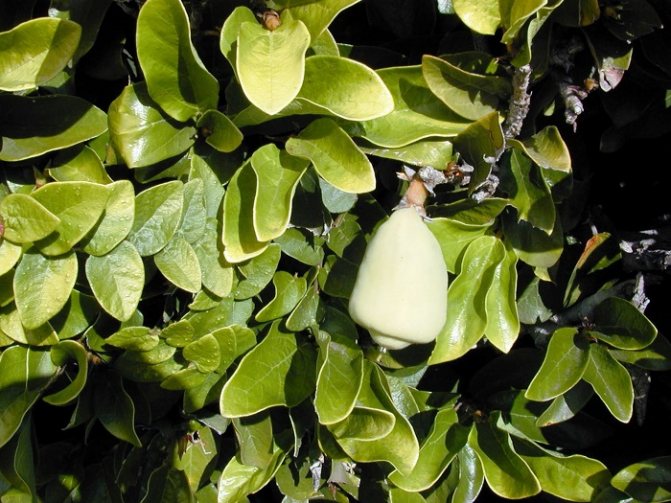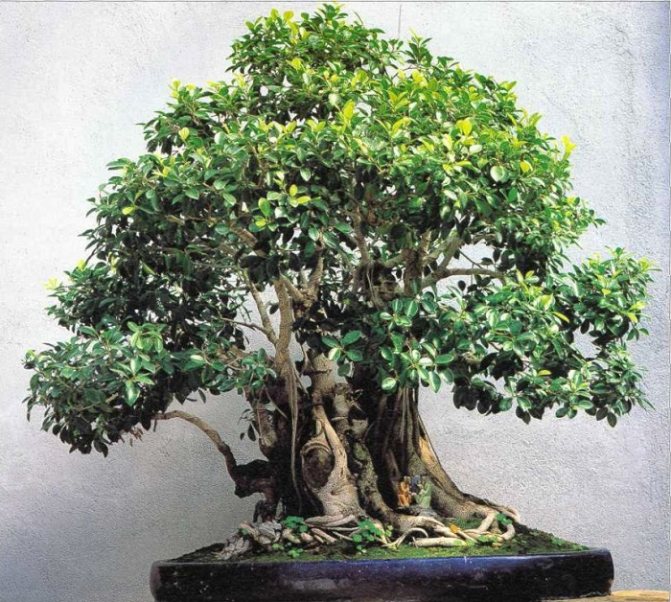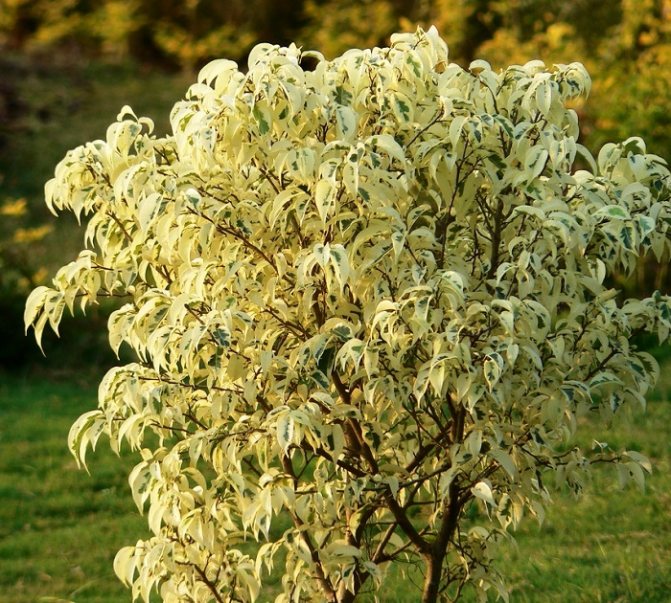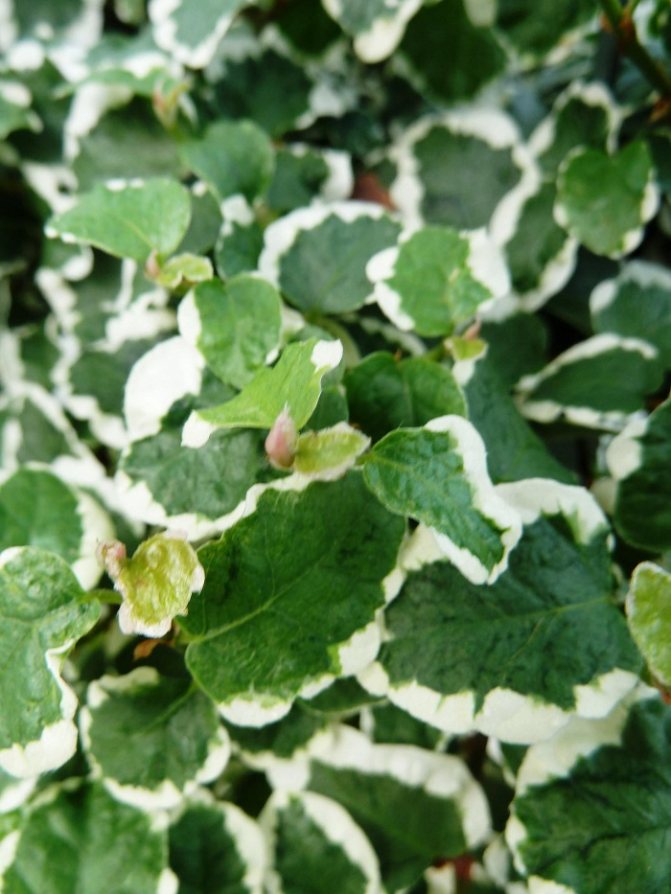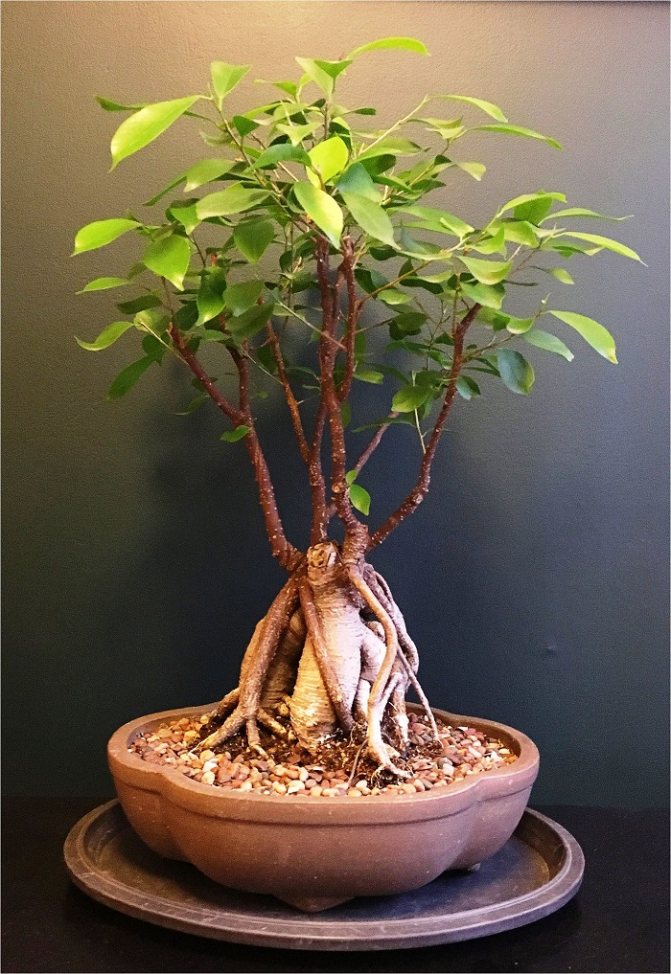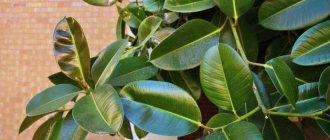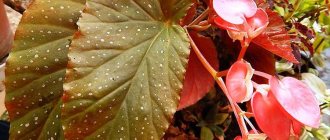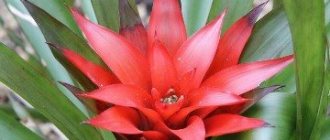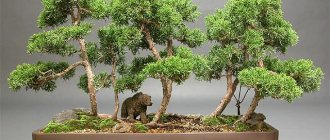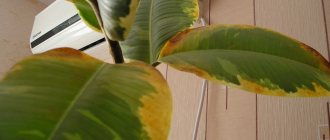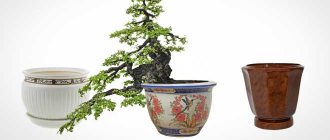Ficus Benjamin came to us from tropical regions, this evergreen tree bears on its short trunk with a smooth gray-beige bark, a broadly branched crown, which is propped up by numerous aerial roots. There are garden forms of Benjamin's ficus, including small-leaved trees. Ficus Benjamin, known to many as a houseplant, does not require much maintenance and is quite suitable as a bonsai. Read about the features of growing Benjamin ficus in indoor conditions in our article.
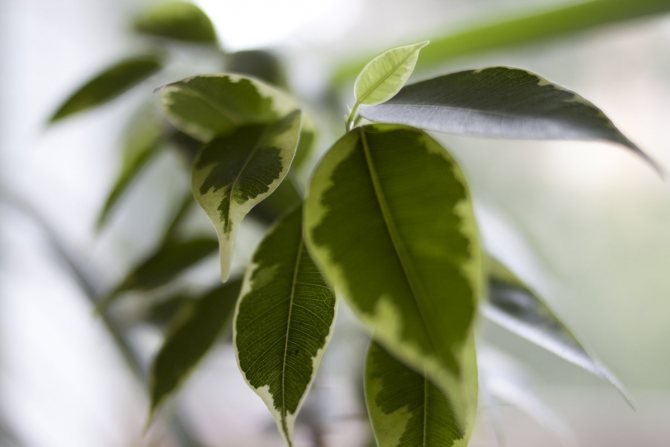
Benjamin's Variegated Ficus
Ficus photo
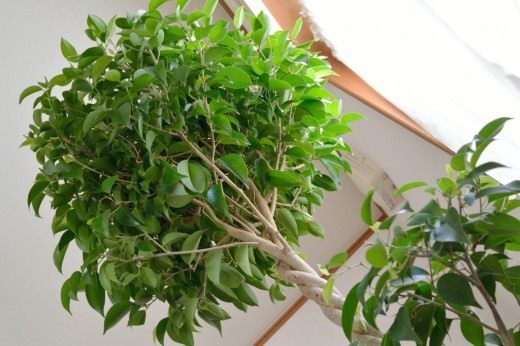

Ficus benjamin (lat.Ficus benjamina). <>
In total, the genus of ficus has more than two thousand species and grows mainly in the tropics and subtropics of Southeast Asia. In Bangkok, for example, this tree is recognized as the official state symbol. There are about 20 species in culture, but their diversity will not leave indifferent any lover of indoor plants. Ficuses come in different heights and shapes, with leaves of various colors - green, variegated, yellow or with white veins. For example, Danielle has shiny dark green leaves, while Monique has a slight curl to the edge. Rianne is very similar to bonsai due to its strongly curved shoots. In addition, there are even plants with bent or intertwined trunks. You yourself can easily give the desired shape to a young tree by carefully intertwining the stems and fixing them together.
Most species of ficuses do not bloom, but their lush crown more than compensates for the lack of buds. In addition, with proper care, the leaves are preserved to the very base of the trunk.
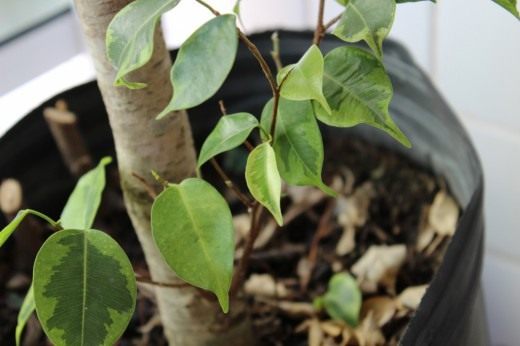

Ficus benjamin.
The place for your pet should be bright, but without direct sunlight, humid and warm. And if your choice fell on variegated ficus, then the light and heat indicators need to be strengthened. From spring to autumn, the plant needs more abundant watering than in winter. But in any case, do not allow moisture to stagnate! To do this, make sure the soil is dry enough before each watering. At high temperatures, the ficus should be sprayed with warm water - the tree does not like dry air very much. If the water in your home is hard, wait for the lime to settle or pass it through a filter.
In spring, the plant can be transplanted into more nutritious soil that allows moisture to pass through well. Large leaves are recommended to be washed with water. All these measures will help prevent diseases and even death of your pet.
If the benjamin's ficus has grown too large, and your household is forced to pass by it sideways, do not be afraid to cut the tree and give it a pretty shape.
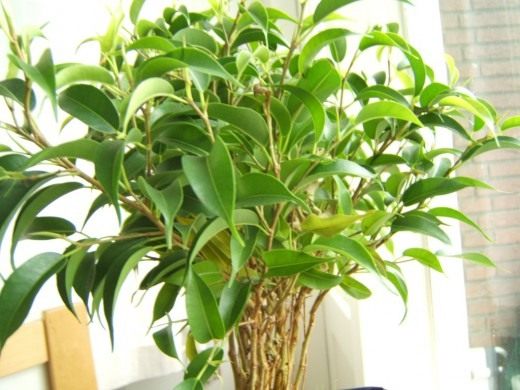

Ficus Benjamin. <>
A friend also wanted a ficus? Give her a gift for March 8th. In the spring, you can separate the green stalk and root it in a closed, warm chamber.
If the leaves turn yellow and begin to fall off, it is possible that the tree is sick. There may be several reasons for this. Examine carefully the place where the ficus is located. Is it standing in a dark corner near the battery or, on the contrary, in the very draft, or under the scorching sun? Take urgent action. It is better to move it away from heating systems and humidify the air at least once a day. Drafts are fatal to ficus!
In addition, too dry air and heat attract spider mites and scale insects. How to determine what exactly this attack happened to your tree? If the leaves are covered with dark, hard plaques, discolored and fall off, this is probably a scale insect. Insects are fixed on almost all parts of the ficus and feed on its juice. Prepare a mild soapy solution and remove the shield with a dampened cotton swab. If the plant is severely affected, treat with Actellik in a proportion of 15-20 drops per 1 liter of water.
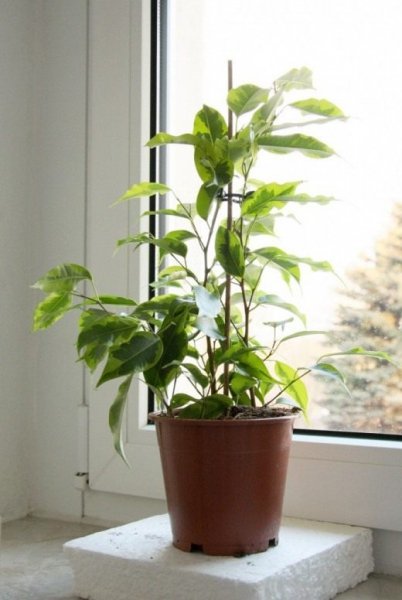

Ficus Benjamin.
If a thin whitish cobweb appears under the leaves or between them, then this is a spider mite. It is necessary to increase the air humidity and make it a rule to wash the ficus with water at room temperature. Does not help? Then Actellik's solution will help out again.
Filled the plant? Roots can rot. Empty the sump urgently and control the amount of watering.
When you follow these simple rules, Benjamin's ficus will delight you with its beauty for a long time and will bring a piece of nature to any corner of your home, which is so lacking for city dwellers.
How to form a crown
It is not difficult to form a crown of a ficus. If you want the plant to have the shape of a lush bush, it is better to plant several seedlings in a pot at once and put them in partial shade. So the ficuses will not stretch too quickly and form a lush crown.
Note: Periodically, the pot with the plant must be turned so that the shoots do not stretch in one direction, and the crown has the correct shape.
If only one seedling grows in your pot, you can stimulate the formation of side shoots by pruning. For this, not the top is removed, but several internodes at once. Once the plant has developed several lateral shoots of suitable length, they must be shortened again until you have a sufficiently lush crown.


Figure 5. Pruning and shaping the crown of the plant
It is noteworthy that the procedure can be carried out only in early spring. Otherwise, not the lateral shoots will begin to develop, but the top, and instead of a lush bush, you will get a fairly tall tree.
Ficus tree at home
Ficus. The most common indoor tree with wide shiny leaves. The ficus itself branches incorrectly, and therefore, in order to form crown trees, it is necessary to cut off the top of it before starting to grow in spring. It is better to keep in winter at a temperature of 8-10 ° C, it is possible and in a place slightly distant from the window.
Creeping Ficus (Ficus repens)
<>
In summer, it is good to place ficuses in a sunny place, on a balcony or in a garden, gradually accustoming them to direct sunlight. Water them sparingly, but spray often.
If young leaves grow small, and old ones hang down and partially turn yellow, this indicates a lack of nutrition, high temperature and dry air.
In winter, it is necessary to often wash the leaves of the ficus from dust and pests.
Ficus rubbery, or Ficus elastic (Ficus elastica)
<>
It is necessary to transplant the ficus annually into the sandy humus soil, and in the summer, during the intensive growth of plants, it is recommended to give liquid top dressing.
Ficuses are propagated by apical cuttings with 2-3 leaves or pieces of stem with one leaf. They form roots in jars or water bottles placed on a sunny window. The water is changed frequently. Cuttings can be planted in small pots in sandy soil, and they root well in a warm, humid place.
Ficus benjamina
<>
Ficuses take root best in indoor greenhouses.
The most common are two types - elastica ficus and Australian ficus. In the rooms, you can also breed creeping ficus, like a climbing and hanging plant.
Transfer
Young seedlings require an annual transplant, and it is better to carry it out in the spring or early summer.Adult specimens do not need such frequent transplantation: it is enough to move the plant to a new pot every 2-3 years, and only if the roots fill the entire space of the pot (Figure 4).
Note: If your ficus is too old and you are afraid that it will not tolerate a transplant, it is enough to replace a few top centimeters of soil annually.


Figure 4. Features of plant transplant
The best soil is a mixture of river sand, peat, leaf and sod land in equal proportions. The culture is transplanted by the transfer method, that is, the culture is removed from the old pot and immediately transferred to a new one, filling the free space with fresh substrate until the container is completely filled.
How to care for a ficus
How to care for this jungle native? In order for the ficus to grow well, it is necessary to create conditions for it that correspond to the tropical ones. Water well in summer and moderate in winter. Each spring, the plant needs to be transplanted into new soil.
The soil is prepared from turf, leafy soil, peat and sand in a ratio (2: 1: 1: 1). It is not necessary to replant mature plants annually; it is enough to renew the topsoil. But if you have just purchased a ficus, then it is not recommended to transplant immediately into another pot - only 1-2 months after transferring it to a new place, otherwise the plant will not have time to adapt to new conditions and can be sick for a very long time.
If the ficus has dark green leaves, a shaded place is suitable for it, and if it is colored, spotted or variegated, then a scattered one.
Ficus
<>
During the period of active growth (spring - summer), the ficus consumes a lot of water, but do not use it in the pan so that the roots do not rot. The water temperature is 20-22 degrees Celsius. Since autumn, watering is reduced, and in winter it is watered no more than once every 10-12 days.
Ficus
<>
In winter, ficus leaves sometimes get sick, often fall off, exposing the stem. This means the room is too dry. Therefore, you should more often spray the leaves or place dishes with water near the heaters in order to increase the humidity in the room where the plant is standing. After all, ficus is a plant in the tropical rainforest of India.
Ficus
Ficus grows better when the room is + 18-24 degrees in winter. He does not tolerate drafts and cold air. Brown spots form on the leaves. Ficus leaves often curl or turn yellow and then fall off. This indicates a lack of recharge. The plant is fed twice a month with liquid fertilizers. In winter, if the ficus continues to grow, feed with half the dose every 2 months.
Ficus
<>
Periodic cutting of the tops promotes more branching and the formation of a beautiful tree.
Plant-safe pruning rules
First of all, in order for pruning to bring maximum benefit and not harm the flower, you must use a sharp, disinfected knife or pruner; scissors are suitable for thin branches. For splitting off, it is necessary to retreat 10-15 cm from the top, that is, approximately 3-4 leaves.
Remember!
If the stem of the flower is thin, it should be trimmed at a 90-degree angle just above the bud. If the stem is thick, then it is cut off at an angle of 45 degrees. The cut begins above one kidney, and ends at the base of the underlying one. A cut to the outside of the bud, with lateral cutting, must be carried out in order not to thicken the plant.
In addition, experts recommend using gloves and glasses when cutting ficus, since milky juice contains toxins that can provoke the development of an allergic reaction. Pruning is best done in the spring, when the plant begins its active growth phase. It is during this period that you can get the maximum result.
Experienced flower growers recommend manipulating when the height of the flower reaches 70 cm.It must be remembered that removing most of the stem can cause the plant to stop growing and remain the same size.
Benjamin's Variegated Ficus
Ficus Benjamin came to us from tropical regions, this evergreen tree bears on its short trunk with a smooth gray-beige bark, a broadly branched crown, which is propped up by numerous aerial roots. There are garden forms of Benjamin's ficus, including small-leaved trees. Ficus Benjamin, known to many as a houseplant, does not require much maintenance and is quite suitable as a bonsai. Read about the features of growing Benjamin ficus in indoor conditions in our article.
Benjamin's Variegated Ficus
What is rubber ficus
Under natural conditions, the height of an adult specimen can reach 30 meters, and its aerial roots, which sink to the ground and take root, also provide a rapid expansion of the crown.
Note: Indoor crops are not so tall, but still large enough compared to ordinary indoor plants, so an adult specimen will be an excellent decoration for a room.
The rubbery ficus has large leathery oval leaves (Figure 1). Blooming at home is almost impossible, since this requires pollination with certain insects. But in any case, flowers do not represent any particular aesthetic value. It is important to take into account that the juice can cause irritation and allergic reactions on the skin, therefore all pruning measures should be carried out with gloves.
What does rubber ficus look like?
Rubbery ficuses that grow in the wild are also called banyan trees because of the numerous side shoots that gradually take root in the ground and expand the crown.


Figure 1. External features of rubbery ficus
At home, the culture practically does not throw out side shoots, but rather quickly grows in height, adding 40-50 cm annually. As a rule, the height of domestic varieties rarely exceeds two meters, but if you provide the plant with good conditions, it can grow even higher. In this case, the crown will have to be thinned out, and the shoots will have to be shortened so that the culture does not rest against the ceiling.
Botanical description of the plant
Ficus Benjamin (lat. Ficus benjamina) is a species of plants from the genus Ficus of the Mulberry family. An evergreen tree or shrub that grows up to 20-30 m in the wild. Distributed in India, China, Southeast Asia, the Philippines, and northern Australia.
Ficus Benjamin leaves are glossy, smooth, thin leathery, oblong-oval with a pointed apex, 6-13 cm long and 2-6 cm wide. The arrangement of leaves on the branches is opposite, the leaves are formed in one plane. The edge of the sheet is full-edged. The venation is reticulate, the central vein is poorly expressed, with 8-12 pairs of lateral veins. The petiole is about 2 cm.
The bark is gray with sparse brown streaks. The crown is wide, the branches drooping. Ficus Benjamin - syconia - round or oblong, paired, up to 2 cm in diameter, red or orange, inedible.
Varieties
Representatives of the ficus family are often found in the collections of indoor plant lovers. Variegated varieties include the following varieties:
- Benjamin. A small tree with a well-developed, dense crown. Leaves are ovoid, with a pointed tip, light green with white spots or edging. The varieties are especially variegated: De Dumbbell, Safari, Starlight, Curly, Variegata, Golden King.
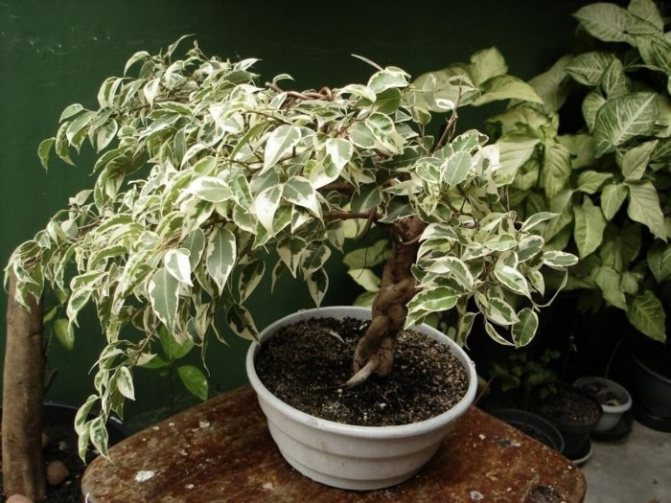

- Binnendi Ali. A fast-growing species, reaching a height of 2 m in room conditions. It branches well, forms a dense crown. Variegated also includes the Amstel Gold variety - a yellow-green hue.
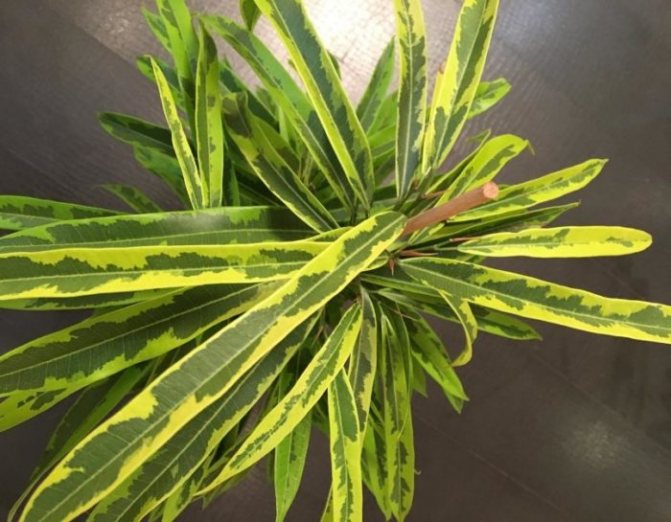

- Rubbery.A plant with a thick stem, up to 2.5 m high. Leaves are oval. Variegated varieties: Robusta, Black Prince, Belize, Tineke.
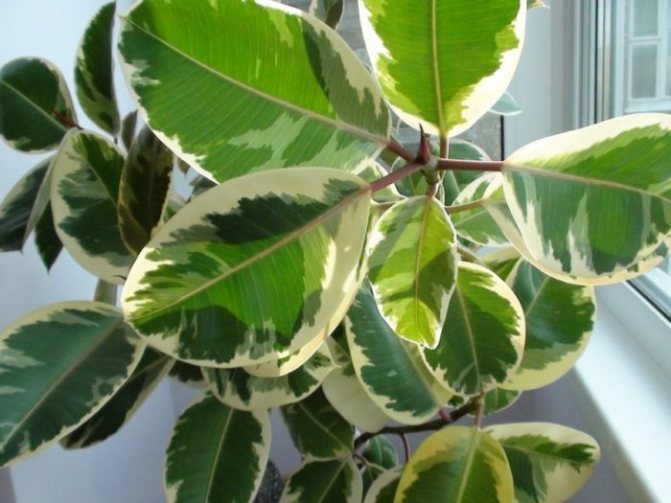

- Dwarf (pumila). Ampelny, a relative of treelike ficuses. Variegated varieties: Sunny, White Sunny, Dort.
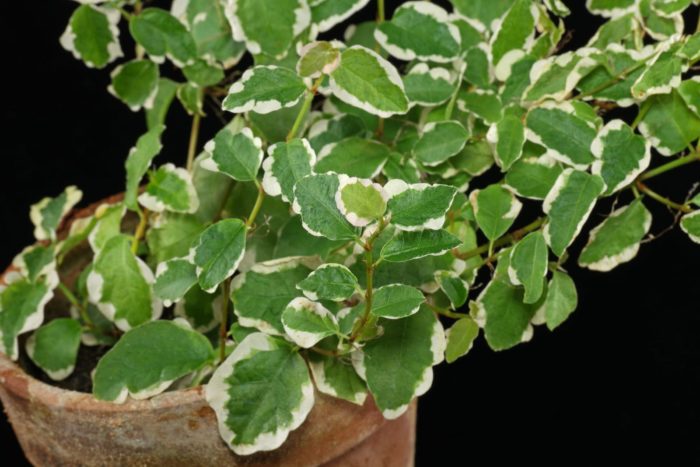

Caring for ficus Benjamin in room conditions
The first weeks of staying in your home
Try to immediately find a permanent place for Benjamin's ficus, protected from direct sunlight. Unlike ficuses with lighter leaves, Benjamin's ficus does not require maximum lighting and will feel great a few meters from a sunny window or in the immediate vicinity of a shady window. Do not place it near batteries or in dry rooms. And also where drafts are possible.
Small-leaved ficus must be sprayed 1-2 times a day. Spraying can be started from the first day. It is recommended to gently shake the Benjamin ficus about once a week, giving air access to the dense foliage of the plant and freeing it from falling foliage.
If Benjamin's ficus came to you in a plastic transport pot, it must be transplanted after two to three weeks. A universal primer or a special primer for ficuses is suitable. If in the first weeks of being at your home, the ficus begins to actively shed its leaves, do not be alarmed - this is the plant that reacts to new conditions of detention. Keep sprinkling and watering it, and pretty soon it will adapt and produce new foliage. For better growth, you can spray the foliage with a weak solution of epin. In winter, ficus dumping up to 30% of the foliage is also a normal process.
Watering Ficus Benjamin
Moderate, however, the earthen coma should not be allowed to dry out. It is important to remember that the frequency of watering depends on humidity, air temperature in the room where the plant is located, and a number of other factors. Therefore, we recommend that before watering, check the soil moisture at a depth of about two phalanges of the finger, especially at first, until you in practice determine how often the ficus will need watering in your home.
Before the next watering of Benjamin's ficus, the soil should be only slightly moist. If the soil is poorly dry, skip watering and loosen the topsoil thoroughly. It is recommended to loosen the topsoil at least once every two weeks. Watering and daily spraying should be done only with settled water (it must be defended for at least 12 hours) at room temperature.
Ficus Benjamina prefers moderate watering. <>
Lighting
Ficuses with dark foliage are not very demanding on light and can grow in partial shade. However, natural lighting is necessary; in its absence, the ficus must be supplemented with a phytolamp.
Fertilizing ficus Benjamin
It is necessary in the period from early spring to mid-autumn once every two weeks with a universal fertilizer. During the dormant period from November to February, it is enough to fertilize the ficus once a month with a half dose of universal fertilizer. Fertilizer is applied only to wet soil immediately after watering. Foliar dressing (spraying the leaves with a weak fertilizer solution) also works well on Benjamin's ficus.
Substrate for ficus Benjamin
A mixture of clay granulate, sand and diving earth in equal proportions. Other mixtures have also been used successfully for this plant. The planting substrate is changed once a year. Older plants require replacing the substrate every two years, and the composition of the substrate must remain unchanged.
Transfer
The plant will need to be transplanted every two to three years. It is recommended to transplant Benjamin ficus in the spring, laying a large layer of drainage in the pot. The transplant can be replaced by renewing the top layer of the earth (about 3-5 cm). After transplanting, the plant can shed its leaves for several weeks.
What is most dangerous for the ficus Benjamin
- Low air humidity, which can cause spider mite infestation and leaf fall.
- Drafts, currents of air, both cold and warm, and sudden changes in temperature, also provoking the release of leaves.
- Excessive watering, causing root rot and dark spots on the leaves.
- Insufficient watering, weakening the plant and provoking leaf shedding.
- Lack of light, watering with cold water, air temperature below 17 or above 23 degrees - all this can cause the foliage to be dumped by ficus.
Ficus Benjamina needs a transplant every two to three years. <55Laney69
Methods for forming the crown of a rubber-bearing ficus
Ficus can be given various shapes. Its choice depends on aesthetic preferences, as well as on the size of the tree.
Stam
The stem of the plant is exposed at the bottom of the excess leaves and young shoots. If the flower pot stands on the window, about 40 cm is exposed, and if on the floor - 90 cm. At the top of the flower, 10 cm is cut off. Thanks to this, the upward growth is suspended, accelerating the lateral.
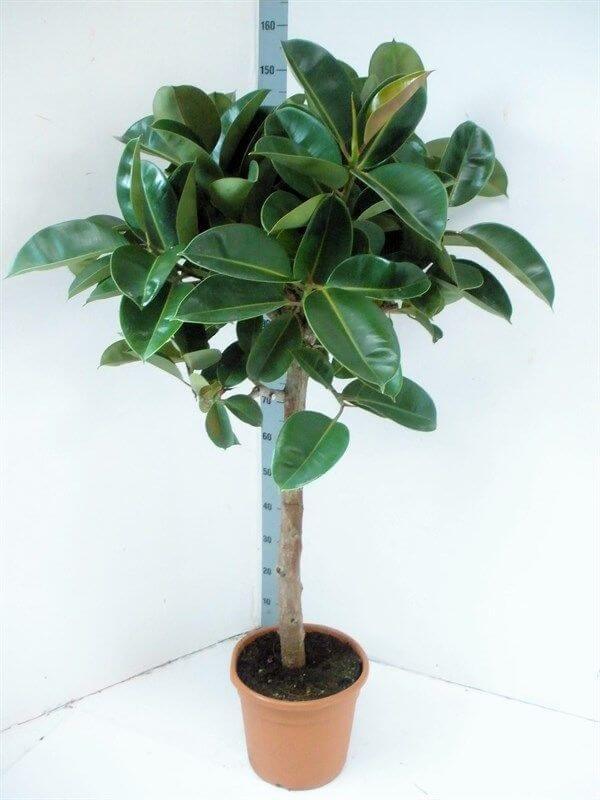

Stam
Having chosen the required height, the lateral branches from the side of the outer bud are pinched so that growth is carried out parallel to the stem and the ficus branches to the sides. Thus, a standard crown type is obtained.
Bush
The bushy crown shape can be formed in several ways. In the first method, the flower is allowed to grow up to 80 cm, after which 10-15 cm of the top is cut off. Lateral shoots need to be pinched if they have reached 10 cm. Trimming the stem helps to activate the growth of the lateral part, due to which the lateral part grows intensively, forming a voluminous crown.
When using the second method, the plant is provided with a constant high humidity. As a result, aerial roots are formed on the stem, which are directed to the substrate. After the roots germinate and take root, they take on the shape of a banyan tree. Regular pruning of excess roots and branches.
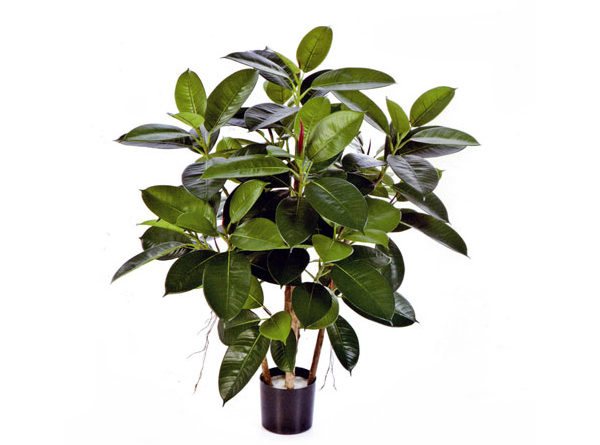

Bush
Arc
First of all, to form an arc, it is necessary to let the plant grow to the required height, after which the top of the tree is cut off. Thus, all forces will be directed to the growth of the plant in the lateral direction.
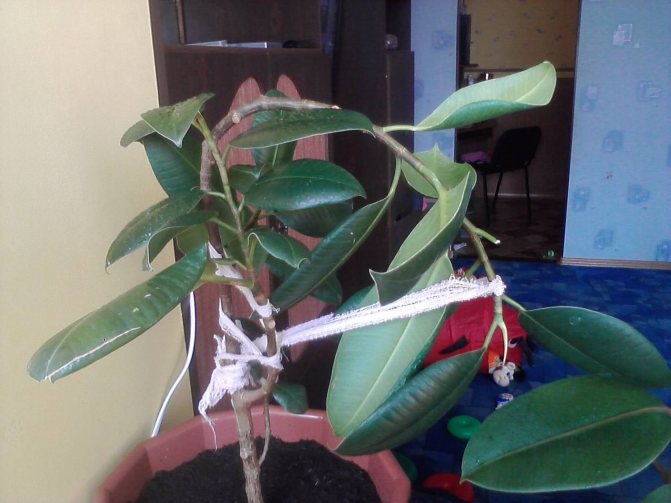

Arc
In order to get a voluminous crown with arched edges, you need to bend and fix the side shoots. In this position, the outer buds of the upper part of the stem are activated and begin to grow actively. The fixation from the shoots is removed after the plant has acquired the desired size and shape.
Spiral
The essence of the method is to fix a support in the pot, it can be a rod or a stick. The stem of the plant is wrapped around the support, having previously freed its lower part from leaves and shoots in order to better see the result.


Spiral
The entwined stem is firmly tied to the support. In this case, the side branches and shoots are constantly cut off so that they do not stick out.
Scythe
The scythe is formed when the plant is still young. Sizes should not exceed 15-18 cm. To do this, plant 3 young shoots in one pot and wait until each of them grows to a height of 18 cm.
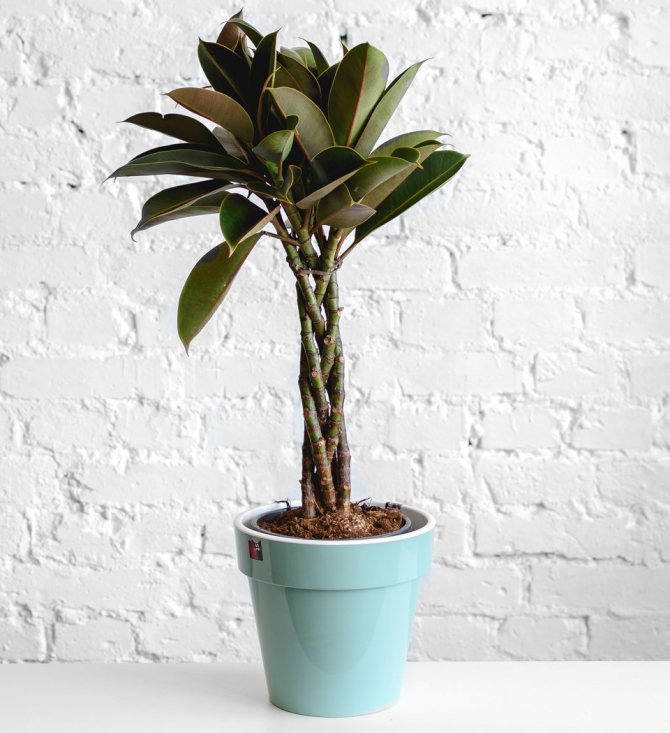

Scythe
After that, the stems begin to weave in the form of a braid, securing with fishing line and threads. From the intertwined parts of the stalk, the top layer of the skin is completely removed, and the secreted juice is removed. The stem is fixed as it grows.
Fence
To form a fence or hedge, the plant must be cut. The cut off shoots are saved and rooted in a large, shallow container, preferably a box, in one row. In growing young plants, the top layer of the bark is cut off, the sap released is wiped off and the stems are connected by tying them together. The growth rate of the stems depends on the amount of light in the room.
Reproduction of ficus Benjamin
Benjamin ficuses propagate by apical cuttings with leaves or pieces of a single-leafed stem. If you put such a stalk in a jar of water on a sunny window and change the water often, then after a while roots will appear on it. Reproduction of ficuses can be achieved in another way: the cuttings are rooted in damp sand. In this case, the stalk is washed from the milky juice that stands out from the cut, allowed to dry a little and planted in small pots with wet sand, which are placed in a warm place, best of all in a greenhouse.
If Benjamin's ficus has lost its foliage, and the leaves are only at the top, it can be updated by resorting to propagation by air layers. In this case, a circular incision is made or a narrow strip of bark is removed under the layering and moss is attached to this place, which is constantly moistened. After 1-2 months, roots develop around the incision. The stalk, along with the roots, is cut off and planted in a pot. The best time to breed ficuses is summer
Suitable microclimate
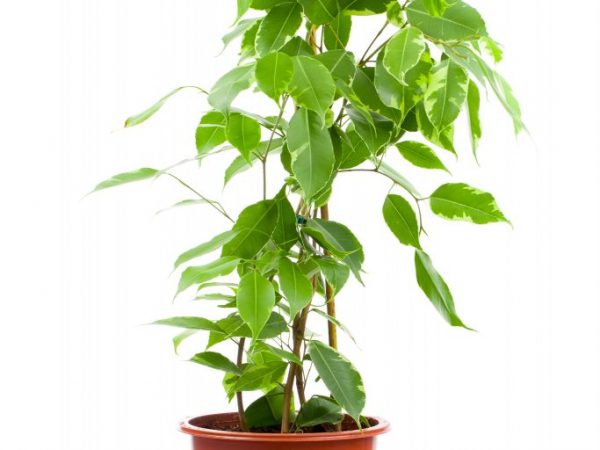

For ficuses, the level of moisture is important
Florists consider variegated varieties to be more whimsical and capricious. Such ficuses are very susceptible to a change in the place of growth and a change in the usual microclimate.
Optimum temperature indicators:
- in summer - no higher than 25 ° С;
- in winter - not lower than 16 ° С.
Humidity
The required humidity is 60-70%. In the winter season, when the air in the room as a result of the use of central heating sources becomes dry, the installation of a container with water near the flower pot or the use of professional humidifiers helps to maintain the humidity at an unnecessary level.
Illumination
Bright illumination is required for an indoor flower throughout the growing season. This will help maintain the variegation of the ficus.
With a lack of light, the foliage becomes faded, loses its gloss and variegation. The required duration of lighting is from 8 hours or more.
Compensate for the deficit in the winter season by using an artificial source - a fluorescent lamp.
Due to the short daylight hours, the pigmentation of variegated varieties is lost, the color can change to completely green, sometimes shedding of the leaf mass is observed.
Direct sunlight is contraindicated in flower culture. Diffused light is recommended.
Plant formation
To obtain a beautiful and healthy plant, it is necessary to form its crown. The vertical shoots of Benjamin's ficus are weak, they quickly take a horizontal direction, and this causes uneven growth of the ficus and is often the cause of a one-sided crown. To keep the bush in an upright position, several plants are planted in the pot and, as they grow, they intertwine with each other, and eventually grow together at the points of contact. Ficus Benjamin easily tolerates a haircut, and since its foliage is small, you can easily form a beautiful curly crown or, slightly lifting the roots, giving them airiness, form a bonsai tree.
Formation of the crown without cutting off the leaves
The desired shape can be formed without trimming. In order to weaken the growth of the kidney, it is necessary to make a vertical deep incision above it and remove the bark around the incision. This method is called kerbovka. You can also use plant hormones cytokines, which affect the acceleration of lateral growth.
Interesting!
The method of fixing the top of the ficus at the base of the stem to the support is considered to be no less effective. This contributes to the fact that the buds, which were from the bottom, begin to actively grow.
It is best to form a crown without pruning for young plants, since they are flexible and will not break, unlike mature ones. To create a uniform crown, it is recommended to periodically rotate the tree in relation to the light.
Diseases and pests of ficus Benjamin
Falling leaves
In the fall, when the days become shorter and the light falls, Benjamin's ficus often sheds a lot of leaves.He loves good light, constant location and temperature. As soon as the leaves begin to fall, or better at the end of September, without waiting for the leaves, move it to the brightest place.
In this case, the crown of the plant should be facing the stream of light with the same side as before. Remember to limit the growth of young leaves in winter by reducing watering.
Ficus Benjamin is an unpretentious evergreen houseplant. <>
Spider mite
If you notice small spiders on the underside of Benjamin's ficus leaves, this is a spider mite.
It multiplies very quickly in dry air and at high temperatures. It is destroyed by thorough washing, especially the lower part of the leaves, with a weak infusion of tobacco dust (4 tablespoons per 1 liter of water), to which soap is added, or infusion of Dalmatian chamomile with soap. After two hours, the leaves are washed with warm water.
If dots and spots appear on the leaves, it may be a shield aphid. This pest is also destroyed by soap-tobacco infusion, to which it is good to add a little denatured alcohol or kerosene. In this case, it is necessary to carefully examine the plant and remove all the shields from the leaves and stems with a cotton swab. The purity of the leaves is the main protection of ficuses from diseases and pests.
Growing flowers with variegated leaves
Variegated varieties of ficuses are more whimsical and capricious in comparison with other representatives of this species. One of the features is getting used to a certain location in the room. Therefore, it is worth taking care of the most favorable place for growing the plant in advance. In order for the flower to develop quickly and delight the owner with its decorative foliage, it is necessary to follow certain rules for caring for it.
What kind of soil is suitable?
Ficus needs the most loose, lightweight soil. Specialty mixes from the store work well.


If you cannot purchase ready-made soil, then you can independently make a mixture of the following components:
- peat - 1 tsp;
- sand - 1 tsp;
- leaf and sod soil - 0.5 hours each;
- clay granulate - 1 hour
Important! Ficuses do not tolerate acidic soils, so a little dolomite flour or slaked lime is added to the mixture.
How to keep variegatedness of the plant?
The main advantage of this variety of ficuses is the original color of the leaves. The absence of chlorophyll-producing cells is responsible for this feature. However, such a state is unnatural for plants, and they tend to recover to their natural green color.
Some tricks will help to maintain variability:
- providing bright lighting at any time of the year.
- reducing the amount of nitrogen in the soil and dressing.
- maintaining air humidity at the level of 60-70%.
- adherence to recommended temperature ranges in different seasons;
- removal of evenly colored shoots.
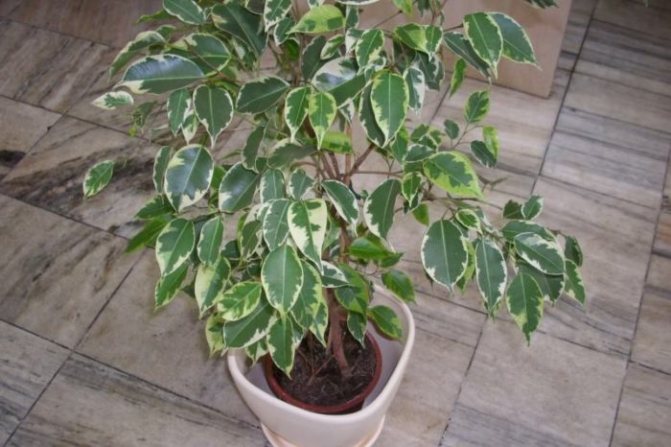

How to propagate at home
Only completely healthy, strong ficus can be propagated. A weakened and diseased plant cannot produce strong offspring. There are several methods of home cultivation of a culture: cuttings and using a leaf.
Cuttings. The most suitable time for reproduction is considered May-June, when the growth of young shoots is activated.
The grafting process takes place in several stages:
- Choosing a cutting. On the stem, choose a strong, strong shoot 10 cm long, with 3-4 nodules, which is carefully cut off at an angle with a sharp knife. All large leaves are removed from the handle, leaving only 3-4 leaves.
- Cleansing the cutting. At the cutting site, milky juice is released from the cutting, therefore, the shoot cannot be rooted, you should wait until the end of the isolation process. To do this, you can rinse the handle under warm water and dry it with a towel, or put it in a jar of water, and change the water to fresh every 60 minutes. As soon as the juice ceases to stand out, the cutting is dried in air for 2-3 hours.
- Rooting. The prepared cutting is placed in a container with clean, not cold water and placed in a well-lit, warm place.
The stalk will be able to form roots faster at an increased level of humidity, so it is recommended to cover the jar with shoots with plastic wrap, which will create greenhouse conditions. From time to time it is necessary to monitor the cuttings, add water to the container, change it to fresh.
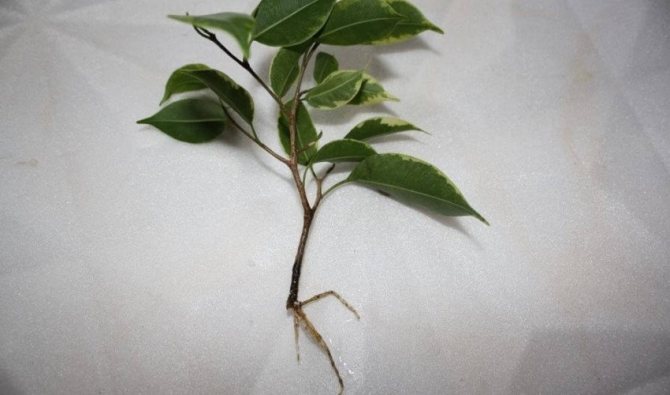

After 4–4.5 weeks, new roots will appear on the cuttings, which serve as a signal for transplanting the plant into a separate container.
Reproduction by leaves. This method is more complicated and time-consuming, so it is rarely used by beginner growers. For reproduction, leaves are selected from the top of the ficus. The leaves are cut so that several internodes remain on them.
Further reproduction is carried out according to the scheme:
- Leaves are planted in the soil specially designed for ficuses, while the petiole should be above the soil level.
- The leaves are pre-rolled in the form of a tube, secured with an elastic band and fixed with a small toothpick. A conditional peg is placed in such a way that it passes through the center of the folded sheet. Such activities will give the petiole stability.
- After planting, the surface of the soil is moistened, and the container with the seedlings is covered with a film.
- The container is placed in a warm, well-lit place, and the sprouts are periodically ventilated.
After 30–40 days, the first leaves will form on the seedlings, which signals the successful rooting of the ficus.
Did you know? Ficus has another unofficial name - a rubber tree, since the milk secreted by a tree is 15% rubber. For this reason, the plant is widely used in industrial and manufacturing fields.
The history of the origin of the plant
Ficus - a plant of the mulberry family (Moraceae), which, by the way, includes the fig tree with edible fruits.
The homeland of the plant is East India, but the information in this regard is ambiguous.
Southeast Asia and northern Australia are called the homeland of ficus.It is in nature a tall tree with a wide crown and falling branches.
However, in indoor conditions, this weeping tree rarely exceeds 2.4 m high, although there are instances up to 3 m.
Formation of ficus elastica - how to rejuvenate a plant by pruning
If it is necessary to restrain the growth of the ficus, pruning is done in a certain way. The same manipulations help to rejuvenate the plant.
Is there any other option? Yes, wake up the sleeping kidney in the right place - bend the top towards the ground. The higher kidney will begin to grow.
You can cut off part of the top, root it and replant it... Several of these cuttings will create bushiness. Another shaping option is to cut the young stalk at the desired height. Any manipulations with pruning should be carried out in the spring., since this is the most active period of growth.
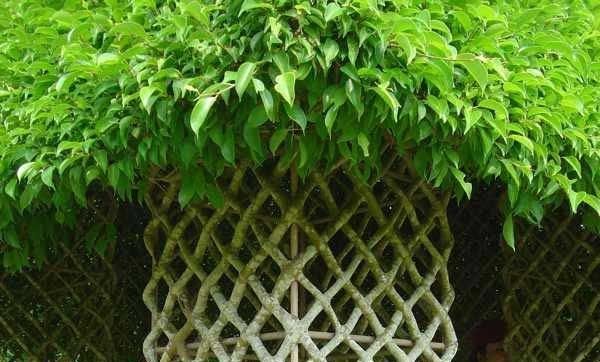

Weaving ficus in vivo
It is interesting to form this plant by weaving. Usually for these purposes, other types of ficus are used, but you can experiment with Elastica.
To form pigtails, three or more young plants are planted in one pot. As you grow their trunks should be gradually weave and fastento keep them in shape.
PHOTO GALLERY
10 Total Score
Ficus rubber at home Feedback from our readers is very important for us. Leave your rating in the comments with the reasoning for your choice. Your opinion will be useful to other users.
Did our article help you?
10
Add your review
Read also: TOP-50 Ornamental plants that purify the air in our house or apartment (50+ Photos & Videos) + Reviews
Conditions for growing at home
Ficus Benjamin refers to unpretentious plants that can be easily grown at home.When growing, you should especially carefully monitor the lighting, temperature and humidity.
Location
The flower prefers good, bright lighting, so it likes to "settle" on the windowsills from the south-east or south-west side of the apartment. At the same time, the plant is sensitive to direct sunlight and can get burns, so in hot weather it is better to darken it.
Important! The color of the leaves and their variegation depend on the lighting, therefore, to preserve the color, the culture should be placed in well-lit places.
If the plant is far from a natural light source, then it needs to organize artificial lighting, for example, using fluorescent lamps. The optimal daylight hours for ficus are considered to be 10-12 hours.
In the summer, when the weather is hot, it is recommended to take the flower to fresh air, avoiding drafts and direct sunlight.
Temperature and humidity
One of the most important factors affecting plant health is indoor temperature. Benjamin's flower feels most comfortable at temperatures of + 20 ... + 25 ° С in summer and + 16 ... + 20 ° С in winter.
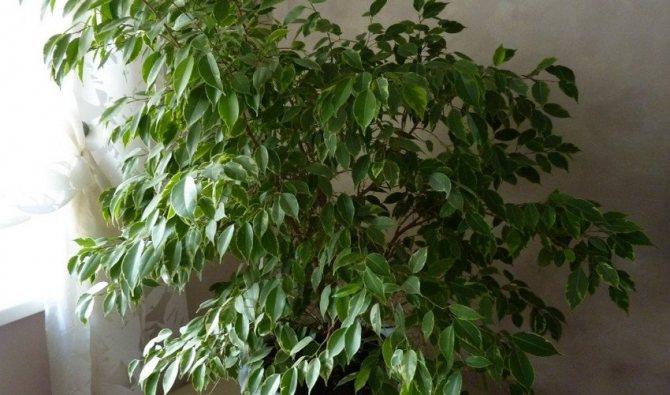

At low temperatures, the growth of the culture stops, therefore, even in winter, its parameters should not decrease below + 16 ° C. It is not recommended to place the flower near heating devices, as this can lead to yellowing of the leaves and their falling off.
Also, the plant reacts negatively to sudden changes in temperature and can completely discard foliage.
For ficus, 70-75% are considered optimal humidity indicators, so it is very important to maintain the proper level in the room. Too low humidity contributes to the "inhibition" of flower growth, and too high - to decay of the root system.
To ensure the required level of humidity in the room, experts advise to regularly spray the foliage of the culture, systematically do a full bath for it, or place a container with water near the pot, an artificial decorative fountain.
Photo
In the photo ficus "Variegated":
We advise you to familiarize yourself with photos and secrets of growing other varieties of Benjamin's ficus, which will certainly create a cozy atmosphere in your home or office: Anastasia, Daniel, Natasha, Kinky, Mix, Starlight, Baroque and Golden King.
Difficulties in growing
Problems that can arise with the health of the ficus are in most cases associated with non-observance of the rules for caring for it.


The fact that a plant is affected by ailments is signaled by its appearance:
- foliage falls, the trunk becomes "bare" - a consequence of excessive waterlogging of the crop or the introduction of a large amount of fertilizer. In such cases, in order for the Benjamin flower to stop shedding its leaves, it should be transplanted into another substrate and the roots should be sanitized;
- the appearance of brown or yellow spots on the leaves - speaks of a negative effect on the plant of direct sunlight or too intense lighting;
- leaves wither, gradually fall - the reason for this condition may be a low air temperature, at which the growth of the culture slows down;
- leaves turn yellow, grow poorly - indicates that a lot or, conversely, little fertilizer has been applied.
Important! It must be remembered that when cutting from the "wound" milky juice is released, which is poisonous, therefore, when cutting branches, it is necessary to use personal protective equipment, for example, rubber gloves.
To find out the reason why small-leaved ficus is crumbling, it is necessary to conduct a visual inspection of the culture for the presence of parasites.
The plant can be affected:
- spider mite, signs of which are also white bloom on the underside of the foliage;
- mealybugwhich appears as white, sticky spots on foliage that resemble cotton wool;
- scabbard, the action of which is expressed by brown spots and growths on the leaves.
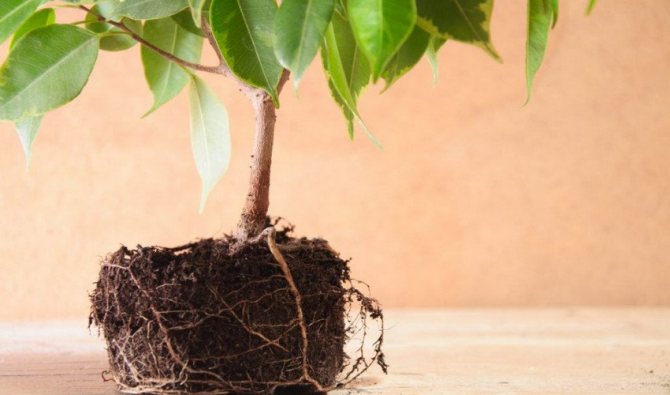

Modern insecticidal preparations with a wide spectrum of action will help to effectively fight parasites. You can also get rid of pests using folk methods, in particular, wiping the foliage and stem with soapy water or tincture of garlic diluted in water.
Small-leaved ficus is a beautiful, original plant that will look harmonious in any interior. In addition to the fact that it has a luxurious appearance and can be of great benefit, since it cleans the air well, saturates the room with oxygen, the plant has a beneficial effect on the microclimate in the family.
Top dressing
In spring and summer, during the period of active growth of shoots and root system, ficus plants need mineral feeding. Nitrogen fertilizers are an excellent solution. The lack of this substance inhibits the growth of deciduous mass.
Among other things, potassium, calcium and phosphorus are vital for indoor flowers. In order not to calculate the dosage for a certain amount of land, you can use ready-made fertilizers. These complex fertilizers only need to be diluted with water and water the plant.
In autumn and winter, when the growing season ends and the ficus is at rest, feeding is stopped: they not only will not bring any benefit, but are also harmful to the plant.
Care features
Watering
Ficuses love water supplied in small quantities, so as not to provoke waterlogging of the soil and rotting of the roots.
In the summer, when the home flower is actively increasing the vegetative mass, watering is increased up to 2-3 times a week, in winter, at the dormant stage, watering is reduced to once every two weeks.
The main rule that should be followed is the drying of the surface layer of the substrate to a depth of 2-5 cm.
When watering at the root, excess water is drained from the pallet after 0.5 hours. When wetting the pots, they are placed in the liquid for 15-20 minutes and the excess is allowed to drain off.
In the hot season, to maintain the required moisture level, they additionally resort to spraying over the foliage and arrange a warm shower. In winter, the plant is not sprayed.
Top dressing
The main feeding is in the spring and summer, when new shoots appear intensively in the ficus. In the phase of active growth, nitrogen-containing complexes are useful.
Fertilization sequence:
- at the beginning of spring, organic matter is introduced at the root - a choice of rotted manure (2 g / 1 l), chicken droppings (5 g / 1 l);
- in summer and autumn (until November) they are fed with minerals.
To maintain the variegation of leaves, potassium and phosphorus are needed.
Fertilizing an indoor flower is stopped from the end of autumn, when it begins to prepare for the dormant stage. The introduction of dressings in winter is possible in exceptional cases, while the dosage is halved.
Crown formation
In the wild, Mulberry trees actively grow in height and at the same time release side shoots.
Indoors, they need regular pruning, which starts in spring.
The technology depends on the goals:
- for flower growth in breadth - shorten the top to activate the development of lateral branches;
- for pulling - cut off the branches from the sides.
Foliage is a direct participant in photosynthesis, on which the nutrition of a flower culture depends. The maximum allowable volume for cutting during crown formation is up to 1/3 of the total weight.
Fundamental rules:
- make the cuts oblique;
- the protruding milky juice is removed with warm water;
- sprinkle wounds with charcoal or activated carbon;
- the first feeding is applied no earlier than 2 weeks after pruning.
What are the benefits and harms of a plant
The plant cleans the indoor air very well. In addition, it is believed that the ficus also cleanses the energy, ridding it of negativity.The juice of this plant, in addition to the production of natural rubber, also has useful properties. Therefore, it is used in folk and official medicine. Compresses with its juice are used in the treatment of diseases such as sciatica, arthritis, hemorrhoids, osteochondrosis. In official medicine, rubber juice is used for the production of drugs that treat mastopathy, uterine fibroids, as the prevention of cancer, etc.
As for the harmful properties, contact with the juice of this plant in its pure form is undesirable, because it can cause allergies and dermatitis. It is also undesirable to keep it for asthmatics, because it can cause them asthma attacks due to substances released into the air.
What is famous for the genus "ficus" from the mulberry family
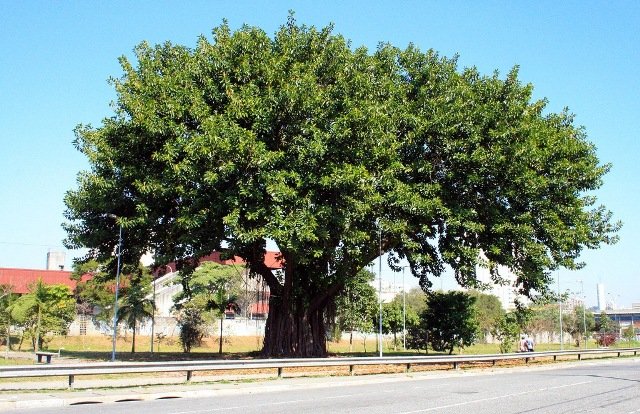

Ficus rubber in its natural environment
In enclosed spaces, rubber ficus is most common. Occupies an area limited by a tub or box and a space around no more than 1-2 meters in diameter. At home in the Indian jungle, the ficus genus is represented by a huge number of useful for aboriginal plants, from giant (under the shade of which more than 100 families can rest) to dwarfs in the form of miniature creeping shrubs. There are also strangler vines. Wrapping around trees, they grow into the owner's trunks and strangle him "in love ecstasy."
For the first time, struck by the size of the crown of the ficus (in modern terms, about 300 m in circumference), this plant was described by the famous botanist Theophrastus more than 2000 years ago.
A closer acquaintance with the family surprises with its diversity and biological characteristics. In the amazing mulberry family, close relatives are:
- figs (fig tree, wine berry, fig, fig);
- mulberry (here, mulberry, king-berry);
- breadfruit (Jacques-tree with fruits weighing up to 20 kg);
- paper tree (the highest quality natural paper is made);
- cow tree (has the taste and nutritional value of milk);
- rubbery ficus (rubber tree, elastic or resilient ficus, contains 17.3% natural rubber);
- upas (anchar) is the most poisonous representative of the genus, perfectly described by A.S. Pushkin in the poem "Anchar".
Read also Liquid from pipe blockages
Problems to face
Variegated decorative ficus and caring for it bring only joy to those people who are very fond of indoor plants.
But ficuses get sick, and the reason for this is improper care, as well as an initially infected seedling or soil.
During the cultivation of an indoor flower, you can face the following problems:
- Black dots on the back of the leaves are cercospora. The fungus that infects the green leaf spreads spores and can infect other indoor plants as well. The affected leaves are cut off, and the entire ficus is treated with a fungicide.
- Spider mites are small creatures that infect the leaves of an ornamental tree. They are easy to spot by the thin cobwebs that twine around the branches and trunk, as well as white spots on the foliage. The plant is washed under warm running water, and the leaves are wiped with alcohol.
- Dropsy - brown growths on leaves, formed due to overflow of soil. Leaves with outgrowths are removed, and the plant is transplanted into a new substrate.
How to prune ficus correctly?
Before proceeding with the formation of the crown, it does not hurt to find out what time of the year it is better to do this.
Many believe that it is best to hold this event in springand they will be right. The formation of the crown planned for this time of the year makes it possible to give the plant more splendor, since it is in the spring that the best conditions for growth are created for the ficus. Using a similar approach, a grower can grow Benjamin's ficus, which will be well developed, having fully formed shoots in all directions.
It is undesirable to transfer pruning of Benjamin's ficus to a later time, for example, autumn or winter, since in this case the shoots will develop within a specific area. This will make the ficus look skewed. It must be borne in mind that at this time of the year the ficus begins use nutrientsthat he has accumulated in the shoots. As a result of pruning shoots in the fall, you will leave Benjamin's ficus without these reserves, endangering his survival.
During the formation of the crown, it is necessary not only to change the length of the shoots, but also to correct the direction of their further growth. For this purpose, special tensioning devices are usually used.
Expert advice
Clean leaves of rubber ficus are a guarantee of his health, since caring for them will relieve scabies and spider mites. For prophylaxis, tobacco dust and soap can be added to the water for washing the leaves. Moisten their surface with this liquid, leave for an hour and a half and rinse with water.
It is unpretentious and resistant to disease, but sometimes the plant begins to wither and shed its leaves. It is necessary to establish the reason. This can be a sharp drop in temperature and a draft, waterlogging, rare watering, insufficient light.
The yellowing of the leaves can be caused by:
- Excess fertilization. You need to stop feeding.
- Decay of roots. An unpleasant smell will report it. It is necessary to remove the plant from the ground, rinse the roots, remove the rot and transplant it into new soil.
- Soil salinity. In this case, a transplant into a new soil will also be required.
- Large flower pot. Replace it with a smaller one.
Proper care of the plant will allow you to admire the beautiful and well-groomed ficus. The benefits of it are great: it cleans the air in the room from toxins and impurities, cleans the energy.
Is it possible to cut rubber ficus
Pruning ficus rubber is needed not only to make the tree decorative, but also to heal the plant. It is necessary to remove excess shoots regularly so that it is healthy, lush, leaves and stems have enough room for growth, all aerial parts of the bush receive enough light and moisture from the air.
Removal of branches is carried out for sanitary purposes - sick, rotten, dry, broken branches pull out nutrient components, taking them away from healthy parts, and can also reduce immunity and cause disease.
With formative pruning, the ficus can be made to branch or grow compactly. The flower grower himself determines which crown diameter is suitable for growing in rooms of different sizes.
When pruning, it is recommended to choose branches that are weaker in appearance, thin, with the presence of old bark, cracks and other damage.
Types of artificial ficus formation
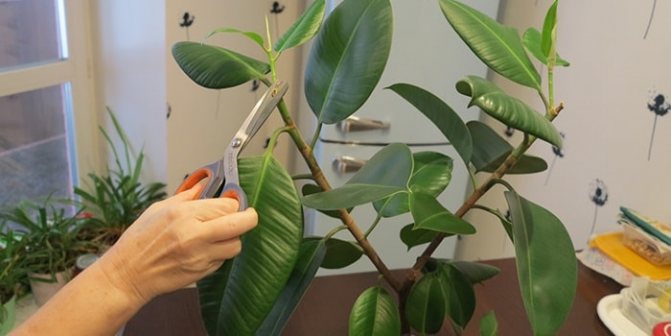

With the help of shaping pruning, you can give the rubbery ficus several interesting shapes that will decorate the interior of any room:
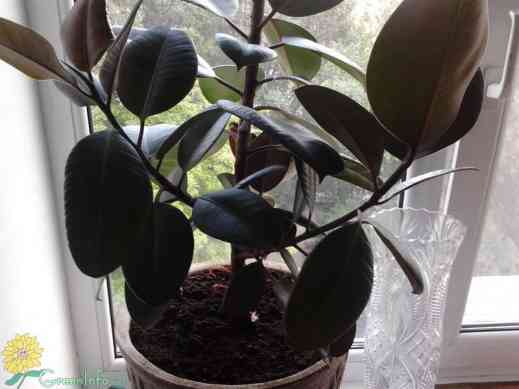

- The first way... To form a bush form, cut off the top of the central stem and all lateral shoots. The top is cut by 10-15 cm at a plant height of 70-75 cm. Lateral shoots are pinched when they reach a length of 8-10 cm. Deep pruning of the central stem stimulates the growth and development of lateral shoots and somewhat suspends the development of the central one. As a result, a cozy bush is formed, under which you can sit and meditate in the air free of microbes.
- Second way. A young plant in conditions of high humidity forms aerial roots, which are directed into the soil. As they take root, they form a banyan tree. With dense root formation, thinning is carried out, removing the roots and branches growing inward.
Stam
To form a stem in a single-stemmed young rubbery ficus, use its ability to grow upward. Leaves fall from below, exposing the stem.In the absence of natural exposure, the lower leaves and shoots are cut off to a height of 40 cm when the pot with a flower is located on a windowsill or other elevation and 90 cm when it is on the floor. The central stem is cut 10 cm, retarding its growth. Young side shoots are given priority in development. At the required height, the lateral branches are pinched (not cut off) onto the outer bud, making it possible to grow upwards parallel to the central stem and in turn branch out. It turns out a standard tree with a crown. In order for the crown to become spreading, there is a technique for forming lateral shoots with an arc.
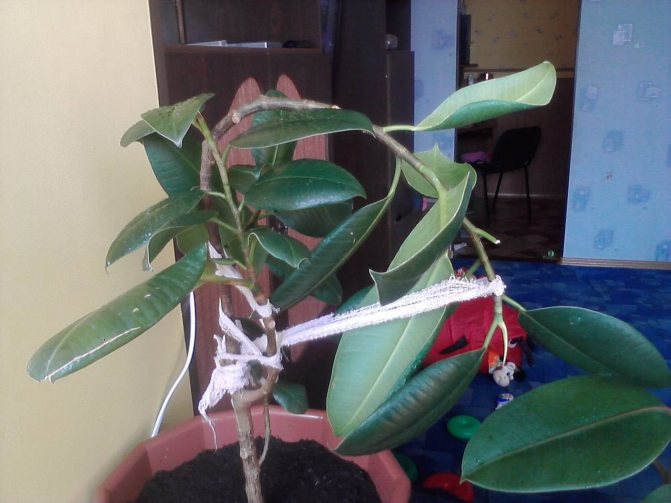

When the central stem reaches the required height, the top is cut off. At the same time, lateral shoots wake up. Ficus rubber grows mainly upward. To get a spreading crown with arched branches, it is necessary to bend the lateral shoots of a young plant and fix it in a bent position. In this case, the lateral buds of the upper side of the curved stem wake up and actively develop. When the lateral shoots reach the desired length, the fixation is removed. It turns out a spreading crown with arched branches on a trunk.
Helpful tips for post-pruning care
If the pruning is done correctly, the plant looks neat and does not appear to have been touched at all. To prevent the ficus from getting sick, it is necessary to periodically inspect the plant for a bacterial infection and follow some recommendations:
ficus after cropping the photo
- a freshly cut plant should not be sprayed, moisture caught on the cuts can provoke the development of the disease;
- do not place a pot of ficus in a draft or in a cold room, the temperature should not be lower than room temperature;
- do not overmoisten the soil;
- be sure to feed the plant, in the spring this can be done immediately after pruning.
Subject to all the rules and recommendations, the ficus, after pruning, will form a crown of the desired shape, but in order for this shape to persist, pruning must be carried out regularly, with a break of 2 months.
An entertaining tree lives in room culture, taking pride of place in an office, an art gallery, a medical institution. It is called indoor elastica ficus or rubbery ficus because a whitish sap is released from the wounds of this amazing plant, which solidifies in the air with an elastic substance (latex). In the native Indian jungle, the tree reaches a volume of 6-10 meters, occupying 300 meters of area. With the help of botanical smuggling, individual representatives of the mulberry family settled for a long time in apartments and offices, including rubbery ficus, the pruning and formation of which gives the exotic the shape of a small and easy-to-care tree.
Growing features
This type is decorative all year round, provided that favorable conditions are created. Lack of light or a sharp cold snap can cause leaves to fall off. Only with proper planting and proper care can a beautiful, healthy indoor flower be grown.
Requirements of variegated ficus to the environment:
- good lighting for 8-10 hours, without direct sunlight;
- high air humidity (50-60%), timely watering;
- the optimal temperature in summer is + 25-30 ° C, in winter + 16-20 ° C, does not tolerate sudden changes;
- keeping in one place, without constant transfers;
- frequent ventilation without drafts, cold or hot air currents.
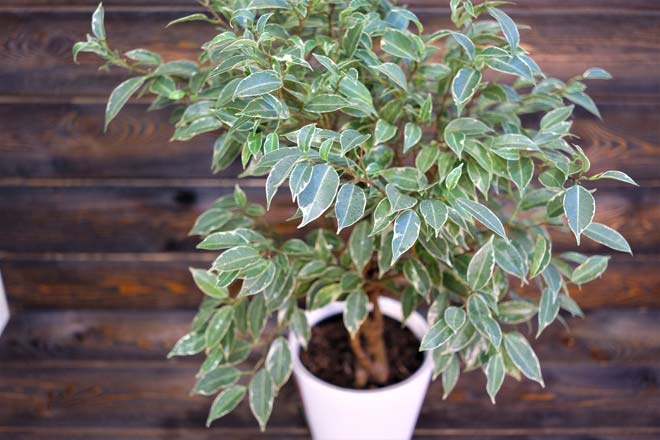

Planting technology and transplant timing
Benjamin's variegated ficus should be planted and transferred to a new pot in the spring. In extreme cases, it is allowed to carry out the operation in the summer. In autumn and winter, it is more difficult for a plant to acclimatize in changed conditions, which will affect its appearance, resistance to diseases and pests.
The first step is to find a place for the flower pot. Ficuses do not withstand constant transfers, each time passing through an adaptation period.The variegated form requires a light window sill, but in winter it will have to be removed away from heating appliances. If it is cool on the floor, the temperature often drops to less than +16 ° C, it is recommended to place it on a special support.
Pot and soil selection
The container should be made of materials that can be easily cleaned and disinfected. For mature plants, it is advisable to use ceramic containers so that the ficus does not fall. The size of the pot should correspond to the root system, when transplanting, it will increase by only 2-3 cm. In too deep, rotting of the roots is possible. The presence of drainage holes on the bottom is mandatory.
It is better to purchase a special nutrient soil with a neutral medium. In the absence of a ready-made soil mixture, it is allowed to prepare it yourself from 2 parts of sod land, 2 deciduous soil, 1 coarse sand and 1 peat.
It is recommended to add charcoal or ash, increase the nutritional value with vermicompost.
How to plant correctly
At the bottom of the pot, pour a layer of drainage from expanded clay or fine gravel, a little river sand, then fill it with the prepared substrate to the middle. Remove the variegated ficus from the previous container, remove the soil, which is easily separated, put in a prepared container and sprinkle with soil mixture. Water abundantly, after 15-20 minutes, remove excess liquid from the pan. Leave the plant for several days, protecting it from direct sunlight and other adverse factors. If the bush drops up to 30% of the foliage, you should not worry, since this is normal for this operation.
When is it time to replant
The recently acquired variegated ficus requires a change of soil, but the transfer is allowed no earlier than 2-4 weeks after the appearance of the bush in a new place. The plant must get used to the changed environment and resume growth. Repot young specimens every year, since the soil is depleted over time, the root system completely occupies the pot.
Air layering
This method reproduces well adult plants with large leaves and stiff shoots. It is more laborious than cuttings or leafy, but it will help the ficus to rejuvenate. It is often used for large-leaved ficus, which has begun to lose its aesthetic appearance, for example, has lost the lower leaves. Another case is large varieties, which, due to their characteristics, have foliage only at the tops.
First, pick the right cut. It should be longer in length than regular cuttings. Sometimes a whole branch can be layered. After choosing a large stem where you would like to see the roots, make a deep notch. To prevent the edges from closing and overgrowing again, you need to erase the juice that has come out, and then insert a match or a small stick into the incision. Another option is to cut off a 2–3 cm section of bark from the broadleaf ficus in the appropriate place.
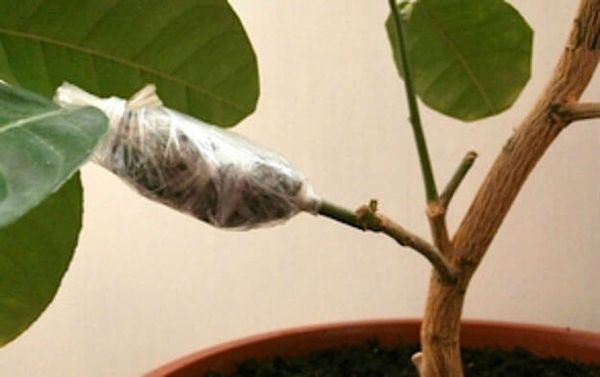

For the best effect, the place of the cut or notch can be treated with a root stimulating agent.
Then wet sphagnum moss should be attached to it - it will provide good nutrition to the young roots and at the same time prevent them from decay. On top of the moss, the section of the stem must be wrapped in polyethylene - not too tightly so that the air under it is still present. At the bottom, the polyethylene must be securely fixed, for which you can use electrical tape. At the top, the fasteners will need to be removed from time to time to moisturize the moss, so it is better to use a thread there.
Hobbyists who have rooted broadleaf ficuses using this method claim that young roots appear at the incision in about 3-4 weeks, but wait two to three months until the roots are large enough to completely surround the moss and become visible. After that, the shoot is finally cut off.
Home care for a young ficus grown from an air layer is as follows: it should be planted in light soil, preferably peat, and at first maintain fairly high levels of soil and air moisture.
Ficus growth physiology
Rubbery ficus (how to form a crown will be described later) can take all sorts of shapes using the pruning process. This will allow the plant to become a real unique decoration for any home. You can do this yourself, the main thing is to be patient and follow the basic rules.
How does rubber ficus grow? New shoots, as a rule, develop from the formed buds. There are two types of them:
- apical (located at the top of the plant);
- lateral, or axillary (located in the axils of the leaves, in those places where the leaf petioles are attached directly to the trunk).
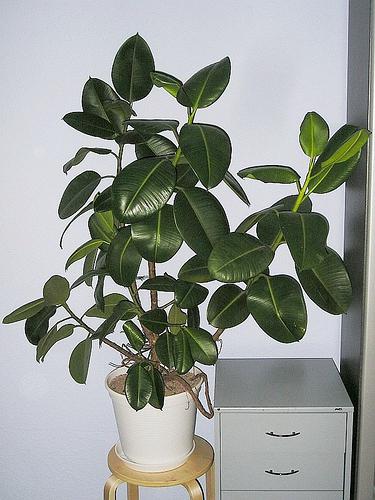

The apical kidney develops at an accelerated rate, while the lateral ones inhibit their development or are completely blocked. If the upper bud is removed, it will activate the lateral buds and the shoots will begin to grow laterally. Thus, the formation of rubber ficus occurs.
Reproduction
Propagated by cuttings, usually in the spring.
Composition of the earth: sand and peat (1: 1) or sand with obligatory covering with polyethylene to create conditions like in a greenhouse.
Rooting in water is possible, but the period is long, about a month.
Rooted cuttings are planted in pots with a diameter of about 10 cm from the ground (from 3 parts turf and 1 part peat) with the addition of a small amount of river sand.
Reproduction by seeds is possible. Sow in a small greenhouse with soil as for grafting. The dive is carried out after the growth of the first leaf, followed by transplantation into a small pot (up to 7 cm in diameter).
Temperature
Variegated forms are thermophilic. If the ficuses have a comfort temperature in the summer from 18 to 23 ° С, and in winter - from 16 ° С, then for variegated ones it is worth focusing a few degrees higher.

